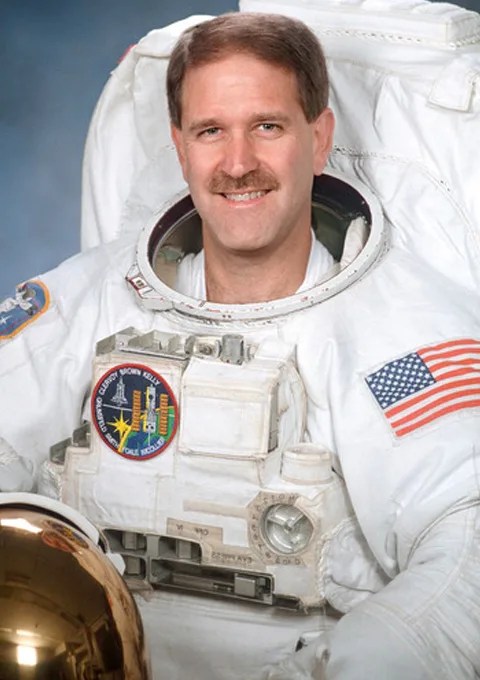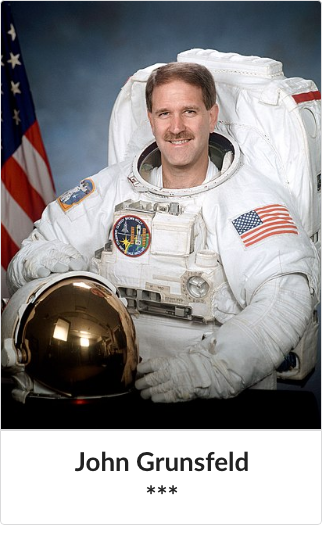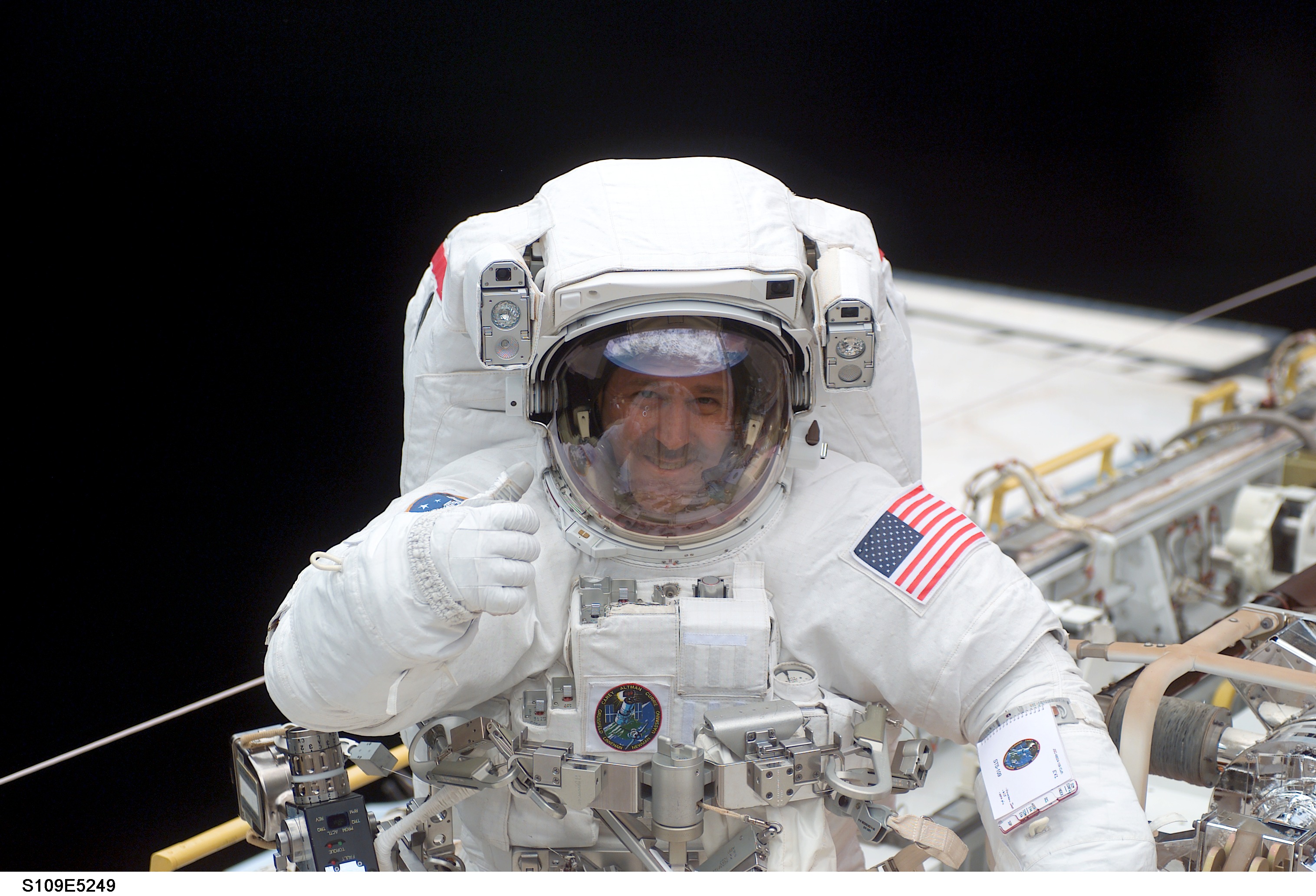
Dr. John Grunsfeld
Astronaut & Astronomer | Former Associate Adminstrator for NASA's Science Mission Directorate
As an astronaut who operated on Hubble multiple times in orbit, Dr. John Grunsfeld has a unique relationship with the telescope. He’s watched Hubble drift against the background of Earth and stars, and he’s guided new parts and instruments into the telescope and left it whole and healthy.
“Once you’re outside working, you know, all the rest of the world disappears,” he once told the New York Times about working on Hubble. “Once in a while the universe lets you be free alone and in peace.”
His quest to become an astronaut started at 6 years old. As a child, he toted a lunch box decorated with a NASA Gemini theme, celebrating an early human spaceflight program. His mother was happy to encourage him, he noted at an awards ceremony. “She thought it would help my interest in science and math and she said there’s no chance I’d ever actually become an astronaut, so she didn’t have to worry.”
The desire to explore space had turned to an interest in physics and cosmology by the time he started college at the Massachusetts Institute of Technology, where he earned a bachelor's degree in physics. After some time in Japan ― where he worked with University of Tokyo astronomer Professor Minoru Oda ― he returned to Chicago and obtained a master's degree and a doctorate in physics from the University of Chicago, basing his doctoral thesis project on cosmic ray data collected by an experiment on the Space Shuttle Challenger.
Once you’re outside working, you know, all the rest of the world disappears.

Dr. John grunsfeld
NASA Astronaut
Following a postdoctoral position at the University of Chicago, he joined the California Institute of Technology as a senior research fellow, where he performed X-ray and gamma-ray astronomy using data from the orbiting Compton Gamma Ray Observatory and a variety of other satellites and telescopes.
But John hadn’t given up on his childhood goal. “When I got my doctorate I applied to be an astronaut, thinking if I don’t apply I know the outcome,” he said. In 1992, he was selected as an astronaut candidate and reported to Johnson Space Center in Texas, where he qualified as a mission specialist after a year in training. His first spaceflight was on the Space Shuttle Endeavour in 1995, during which he and the crew used ultraviolet telescopes to study faint astronomical objects and the ultraviolet light coming from hot stars and distant galaxies.
In 1997, he was flight engineer for a 10-day Space Shuttle Atlantis mission, which docked at Russia's Mir Space Station. During that mission, more than three tons of food, water, equipment and supplies were moved back and forth between the two spacecraft. While on board Atlantis, John entertained National Public Radio listeners by calling in to the popular car repair show, "Car Talk," hosted by Tom and Ray Magliozzi, to get the hosts’ opinion on the perplexing behavior of “this government vehicle” he was driving.
After the second mission, NASA had him begin practicing engineering tasks for a future Hubble mission. “I thought, wow, maybe there’s a small chance I would get to go to Hubble,” John said.

He would end up working on three separate missions to repair the Hubble Space Telescope, including a flight aboard the shuttle Discovery in 1999, Columbia in 2002, and finally Atlantis in 2009, earning him the nickname of “Hubble’s repairman.”
“I thought, you know, this is the holy grail of being an astronaut,” John recalled marveling at his first mission to Hubble.
During the 2009 servicing mission, the final space shuttle visit to Hubble, John was the lead mission specialist, heading up the planning for all spacewalks. John installed two new instruments — the Wide Field Camera 3 and the Cosmic Origins Spectrograph — on Hubble, and helped replace a guidance sensor, six new gyroscopes and two battery unit modules.
"You know, I can't imagine anywhere I'd rather be than outside the space shuttle in my space suit next to the Hubble Space Telescope. I was just so happy," he told the news show “60 Minutes.”
John's adventuring took place on the ground as well as in outer space. In 2002, he and NASA consultant Howard Donner tackled North America's highest peak, Mount McKinley, as part of a study on how altitude affects body temperature. The research required the men to swallow tiny, pill-sized thermometers, which measured their temperature during the trek. The pair, whose efforts were featured in a PBS NOVA episode titled "Deadly Ascent," reached 17,200 feet before having to turn back due to eight days of stormy weather. Disappointed but undaunted, two years later, John became the only American astronaut to reach the summit of Mount McKinley, leading a team of other NASA explorers.
John served as the NASA chief scientist at NASA Headquarters in Washington, D.C., from 2003 to 2004, where he helped develop the President's Vision for Space Exploration. After his final visit to Hubble in 2009, he became deputy director of the Space Telescope Science Institute in Baltimore, Maryland, where he managed the science program for Hubble and the upcoming James Webb Space Telescope.
He returned to NASA Headquarters in 2012 to become associate administrator of NASA’s Science Mission Directorate, leading and overseeing the space research program in Earth and space science and managing over 100 missions before his retirement in 2016. Today John is an emeritus scientist at Goddard Space Flight Center, working on Hubble observations of Jupiter’s moon, Europa, and collaborating on the design of the next generation of space-serviceable telescopes.
In 2015, he was inducted into the US Astronaut Hall of Fame.
“Our mission is to innovate, explore, discover and inspire …” he said at the induction ceremony. “It’s pretty incredible that we have a third of our nation that has grown up in a world that has known a Hubble Space Telescope and many of our developments there, the Hubble generation.”
